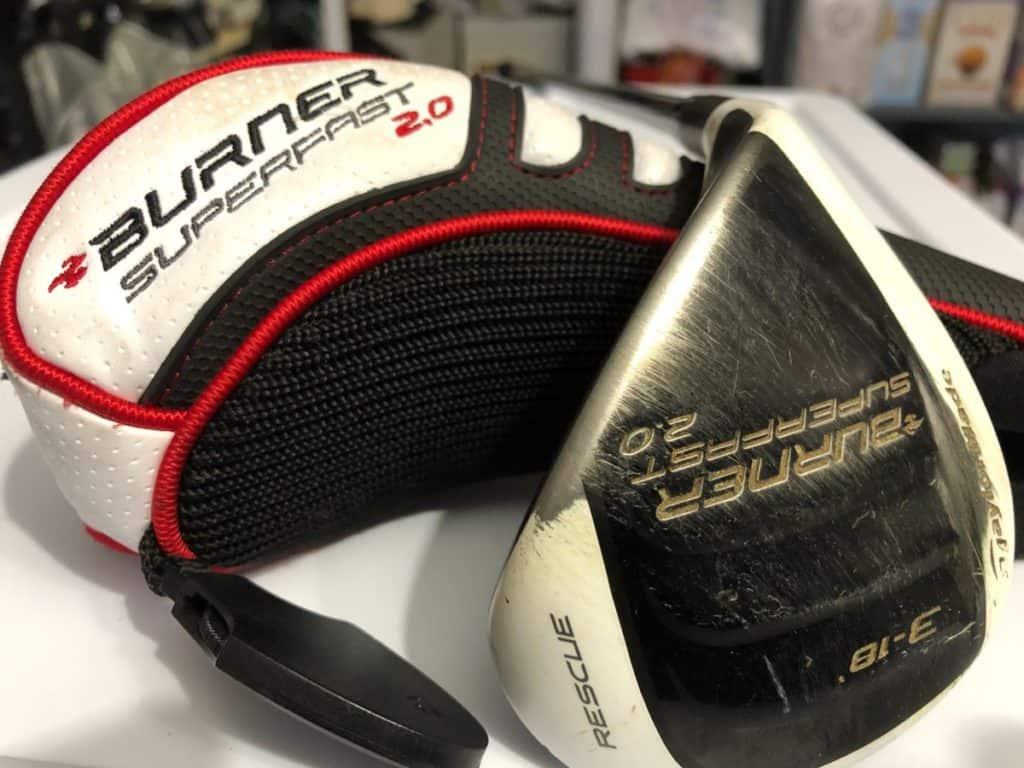
Most golfers struggle with long irons, which increases the likelihood of replacing them with hybrids. A 3-hybrid and 4-hybrid are the most popular choice as they are more forgiving on mishit and increase the loft angle. But which of the two should you use while out on the green?
You should use a 4-hybrid rather than a 3-hybrid because it features a shorter shaft length and a lower loft angle. Coupling perimeter weighting, lower center of gravity, and a shorter graphite shaft create a larger sweet spot, 4-hybrids send the ball higher while increasing striking accuracy.
The rest of the article will examine both hybrid clubs in greater detail to help you pick the best club for your golfing bag.
3-Hybrid: A Basic Overview
As is the case with hybrid clubs, golfers pick a 3-hybrid over a 3-iron because it allows for more consistency in their game, making golfing even more enjoyable. Fairway woods make for incredibly difficult strikes from the decks, and hybrid clubs ease the golfers’ challenges while hitting the long irons.
The clubhead design and head size help improve a golfer’s confidence. A 3-hybrid is more forgiving and more comfortable to launch than a 3-iron. With a 3-hybrid, you’re sure to increase the striking distance, consistency, and accuracy.
Features of a 3-Hybrid
Loft Angle
Commonly known as loft, the loft angle is a crucial degree measurement of all golf clubs’ clubheads. It measures how much the face of a golf club angles upwards relative to its shaft.
A 3-hybrid has a loft angle of between 22° and 23°, which is relatively low. The lower loft angle allows you to hit the ball further without causing it to launch high up in the air.
Clubfaces with higher loft degrees are more horizontally angled, while those with lower loft appear close to vertical.
The lower loft ensures that the 3-hybrid club comes with a face that’s angled close to vertical. In a standard golf set, the loft on the golf clubs increases as the shaft length reduces. That’s to say, clubs with the least amount of loft will have the longest shafts. In this case, a 3-hybrid has a lower loft and a longer shaft than a 4-hybrid.
Clubhead
While the clubhead of a typical 3-hybrid resembles a fairway wood, it’s usually made of hollow titanium or steel and features a slightly convex face. The convex shape is a staple in woods, and it gives the fairways forgiveness that’s lacking in long irons.
The curvature on the clubhead creates a gear effect, a shot correction that helps to straighten the shots that are hit slightly off-center on the heel or the toe.
The clubhead of a 3-hybrid is marginally smaller than that of a 3-wood, but the sole is more forgiving. The center of gravity of a 3-hybrid club is nearer the clubface as the head doesn’t extend backward. The clubhead is optimized for better accuracy and control.
Materials
A 3-hybrid golf club is made from iron, graphite (carbon composite), and steel, making it harder than standard fairway woods.
As the name suggests, hybrids are a cross between a fairway wood and an iron, making it remarkably different from either of them. The clubs combine the strength of each.
Notably, hybrids have the shorter shaft lengths of irons and the bigger head of fairway woods. As a result, they blend iron’s swing mechanics with the better distance and forgiving nature of wood.
Shaft
Typically, a hybrid shaft is slightly longer than that of an equivalent iron. Most 3-hybrid will be between 0.5 to 1-inch (13 to 25 mm) longer than a 3-iron. However, some manufacturers make hybrids that are up to 1.25 inches (31.75 mm) longer.
The standard 3-hybrid golf club features a graphite shaft, making it lightweight but slightly heavier than a fairway wood. A graphite shaft makes for faster clubhead speed.
The shaft on a 3-hybrid is a tapered tube with a 0.5 inches (13 mm) diameter near the club’s grip.
Distance
Since 3-hybrid replaces the 3-iron, the average golf can expect to hit 180 to 240 yards (164.6 to 219. 5 meters) with it. Naturally, some players can hit their balls farther, but most golfers fall within this range.
On average, hybrid clubs give you an additional 4 to 12 yards (3.7 to 11 meters) on the shot because they make it easier to connect than traditional irons. The club’s unique shape decreases the ball roll, but the extra distance on the shot more than makes up for it.
4-Hybrid: A Basic Overview
A 4-hybrid club is meant to help the golfers overcome the inconsistency and inaccuracies of striking the long irons. Often referred to as rescue clubs, hybrids are popular with beginners and intermediate golfers, even the pros.
Since a 4-hybrid confers similar benefits to a 3-hybrid, they are often used interchangeably during the gameplay. However, a 4-hybrid is more forgiving than a 3-hybrid because it’s slightly shorter.
Features of a 4-Hybrid
Loft Angle
The loft on the typical 4-hybrid is higher than a 3-hybrid range from 23° to 28°. Due to the higher degrees of loft, a 4-hybrid golf club is more horizontally angled than a 3-hybrid.
The horizontal angling makes the clubs perfect for hitting a ball sitting low in the rough or hitting off tight lies. A 4-hybrid club hits the ball farther instead of upwards because the clubface is more horizontally oriented. So, the ball doesn’t rise and fall sharply during its trajectory.
Loft manipulation is crucial during a round of golf to compensate for various factors such as wind. If there’s a strong wind blowing during the game, using a 4-hybrid will be more forgiving since it doesn’t keep the ball in the air for a long time.
Materials
As is the case with all hybrid clubs, a 4-hybrid is made from iron, graphite, and steel, giving it a higher degree of hardness than woods.
It boasts a clubhead made of hollow titanium or steel inspired by the fairway woods to allow for faster swing speeds and high impulses on impact.
The hollow clubhead design is deliberate to allow these clubs to replicate the famous trampoline effect found on fairway wood clubs. The clubface deforms slightly on impact with the golf ball to increase its impulse before returning to its original shape.
As is the case with a 3-hybrid, the 4-hybrid combines the strength of the fairway wood and iron clubs. It features a shorter shaft than an iron club and the bigger clubheads found on the fairway wood club. As a result, it swings like an iron club with the forgiving nature and the longer distance of a fairway wood.
Shaft
As with 3-hybrids, a 4-hybrid club’s shaft is between 0.5 to 1-inch (13 to 25 mm) longer than a 4-iron, but some clubs can be 1.25 inches (32 mm) longer. Like the irons, a 4-hybrid has a shorter shaft than a 3-hybrid, making it more forgiving than the latter on mishits.
Like all hybrid clubs, a 4-hybrid comes with a 0.5 inch (13 mm) diameter graphite shaft that may weigh the same or be slightly heavier than the corresponding wood. Depending on the length and material, the golf club’s shaft can weigh between 1.6 to 5.3 oz (45 to 150 grams).
Shafts fall into five main categories depending on their flexes, which refers to how much a shaft bends when placed under load:
- Lady/women’s
- A/I (Soft Regular, Intermediate, Senior)
- R (Regular)
- S (Stiff)
- X (Tour Stiff, Strong, or Extra Stiff)
Distance
A golf ball hit with a 4-hybrid club travels almost a similar distance as one hit with a 4-iron. A 4-hybrid delivers an additional 5 to 8 yards more than a 4-iron.
It’s the ideal club if you value a little more consistency over distance when golfing. While the distance traveled by a golf ball following a strike with a 4-iron and 4-hybrid might be similar, its trajectory is remarkably different.
On average, a male golfer gets 170 yards (155.4 meters), a female golfer 150 yards (137 meters), but professional golfers can range up to 200 yards (182.8 meters) with a 4-hybrid.
Clubhead
As is the case with all hybrid golf clubs, the 4-hybrid comes with a hollow titanium or steel clubhead with a shallow convex face. Although similar to a fairway wood, the head comes with an iron-like lie angle, making a flatter sole.
The head is marginally thinner and doesn’t extend backward as a fairway wood, but it’s more face-to-back than an iron club. The shape and design push the club’s Center of Gravity to the back of the face, making it easier to send the ball flying.
The smooth, curved edges on the 4-hybrid make the clubs an ideal choice when on the rough since they reduce drag and won’t snag in the thick grass.
Which One Should You Choose?
Ideally, it would be best if you had a 3-hybrid and a 4-hybrid on your golf bag. Although the clubs are similar, these two hybrids deliver different results when you’re out on the golf course.
A 3-hybrid has a low loft and has a low center of gravity, thanks to the added weight and mass at the back of the head, and it makes it easier to hit the ball into the air without sacrificing distance. It lowers the challenge of making difficult shots from the fairway or rough by increasing your hitting distance and accuracy.
A 4-hybrid has the same qualities and, therefore, the same advantages as a 3-hybrid, except it has a much shorter shaft. Consequently, it will send the ball higher than a 3-hybrid, but the distance will be slightly shorter and roll even less.
Conclusion
Typically, it’s advisable to have both a 3-hybrid and 4-hybrid in your golf bag as they come with different loft angles and shaft length.
The main difference between the two clubs comes down to the loft angle and the striking distance.
If you were to get only one of them, consider going with a 4-hybrid as it has a much shorter shaft, making it better for accuracy and distance.
